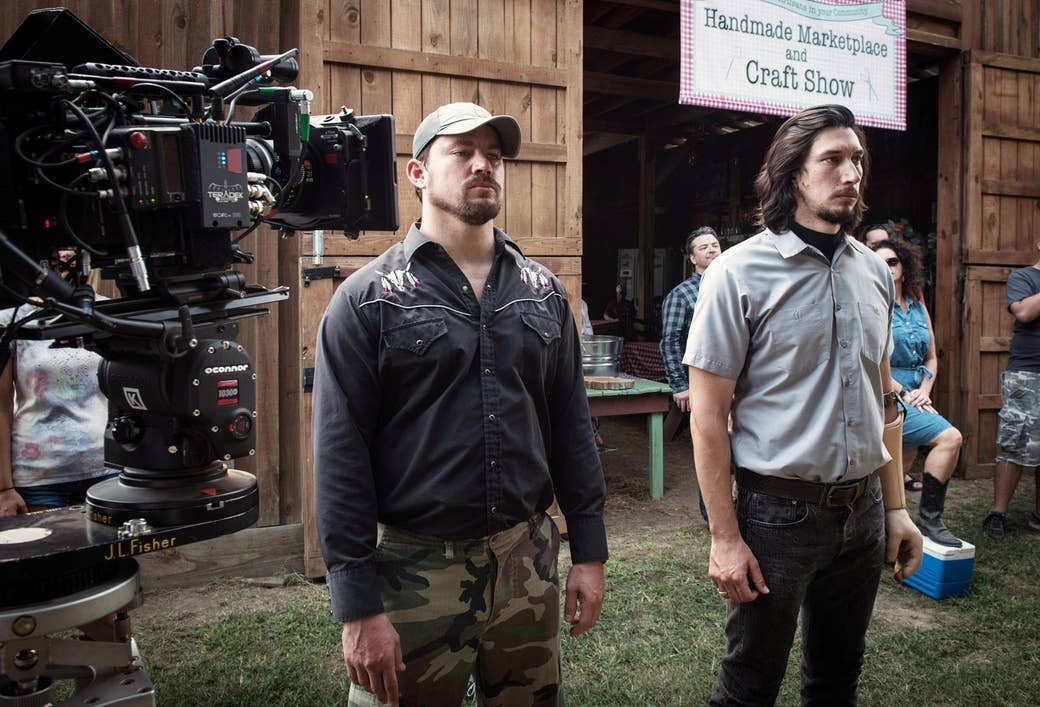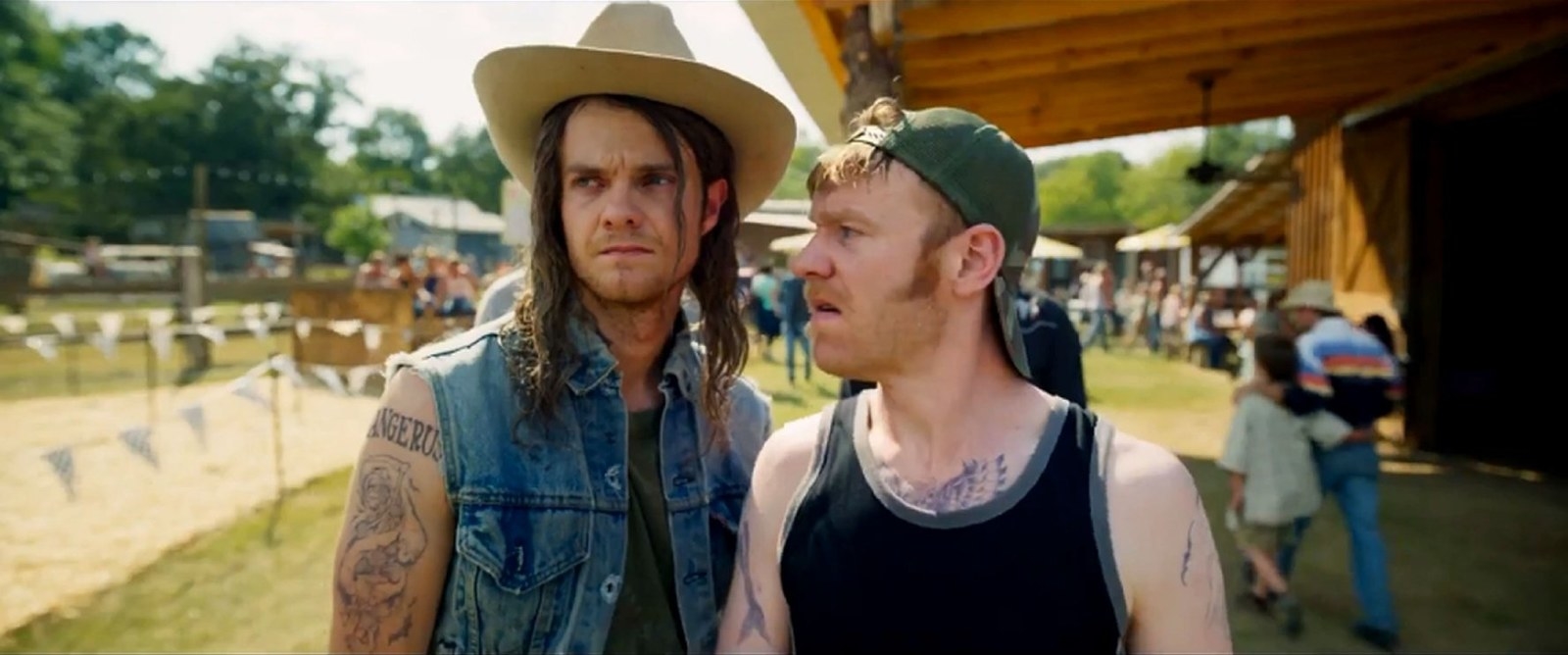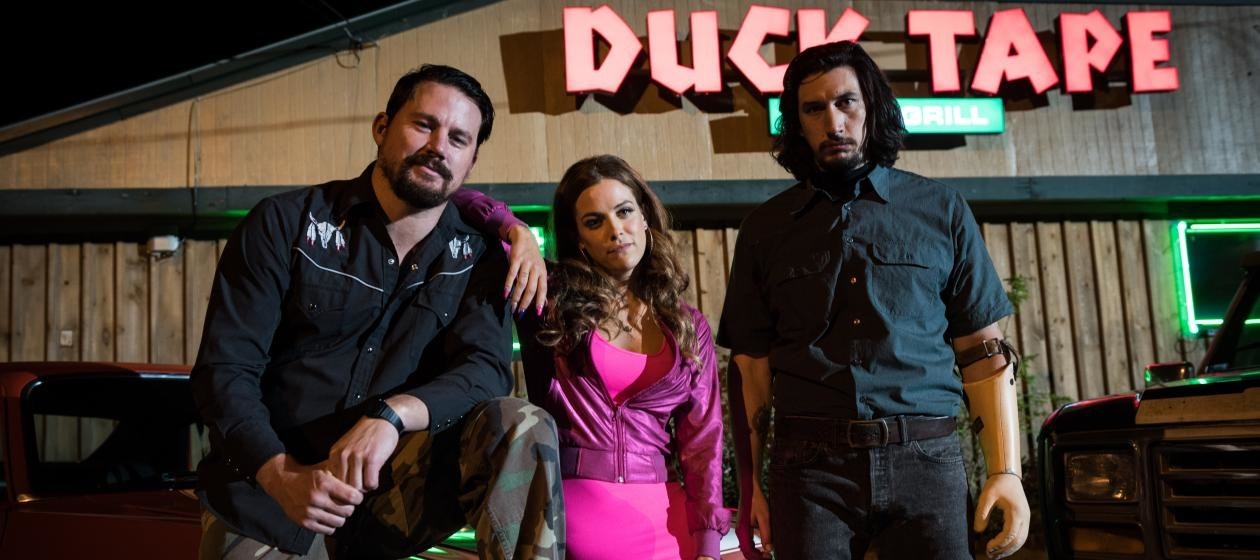
The first thing you hear in Steven Soderbergh’s new film, Logan Lucky, is the exaggerated drawls of Jimmy Logan (Channing Tatum) and his daughter (Farrah Mackenzie) discussing Logan’s favorite song: John Denver’s “Take Me Home, Country Roads.” As Jimmy works on the engine of his truck, he explains that the songwriters, Bill Danoff and Taffy Nivert, came up with the lyrics, but never intended to sell the song to Denver. But once Denver heard the song, which would go on to become the unofficial anthem of West Virginia, he had to have it.
“I just like the story,” Jimmy says.
It feels like a throwaway line — a cute way to introduce a father and his daughter. But there’s no such thing as a throwaway line or character in a Soderbergh film. In hindsight, this scene is the first of many that tell the viewer, in some ways more overt than others, that this movie is much more than a “hillbilly heist.”
“Take Me Home,” after all, was written by someone who’d never been to West Virginia. It’s an idyllic story, an idea of what West Virginia stands for, that its residents have embraced. When faced with a choice between myth and reality, most take the myth. Logan Lucky burrows deep in that myth, sets up shop, and demolishes its core — even as it sustains the generic shell of the hillbilly heist. It’s an incredibly entertaining movie that will undoubtedly become a staple of cable television and on-demand. But it’s also a sly indictment of Trump, and the pervasive myths — of his own business acumen, of the white working class — that have shepherded his rise.
No matter if it’s a film or a book or a documentary, we generally gain our bearings in narratives by recognizing (or being told) the genre of a work. In a romance, people will fall in love; in a mystery, something unknown will become known; in a Western, the cowboy preserves freedom, masculinity, America, white dominance, etc. Every genre has known characters and expected narrative trajectories; to fiddle with the genre (changing the backdrop, the time period, the aesthetic, the expected ending) works to either confirm or revise the way we expect the world to work.
“Generic” has become a pejorative term — a way to say that something relies too heavily on known and worn paths of a given genre. But those worn paths, with their clearly visible destinations and legible morals, can be incredibly pleasurable. Take the Fast & Furious series, or every Nicholas Sparks movie, or the vast majority of superhero movies: We buy tickets to these movies en masse in no small part because we know exactly what sort of narrative experience (and characters, and closure) we’ll be getting.
Producers use genre to get movies made; studios use genre to get you in seats. Genre is a promise, and a contract — you can fiddle with it, pushing the boundaries of that agreement, but you can’t break it. This is why, when movies are mismarketed — say, sold as a thriller instead of an introspective drama (see, for example, In Bruges) — audiences rate them poorly: not because the movie was bad, necessarily, but because they were sold a false bill of goods.
But audiences are willing to hang with most genre revisions and play, so long as that overarching agreement remains intact. Many of the greatest Hollywood directors — including Billy Wilder, Alfred Hitchcock, Robert Altman, and Clint Eastwood, in whose company Soderbergh is often placed — made their most successful films (critically and financially) when they fiddled with a genre just enough for it to feel like a revelation. See: Wilder’s Some Like It Hot, Hitchcock’s Psycho, Altman’s M*A*S*H, or Eastwood’s Unforgiven.
Like the Coen brothers, who’ve methodically worked through every possible Hollywood genre, many of Soderbergh’s biggest financial successes have happened when he’s seemingly tinkered the least, including Ocean’s Eleven, Twelve, and Thirteen, all fairly straightforward updates of a loose (and straightforwardly generic) heist film from the ’50s. But his other major successes have been the result of turning genre ever so slightly on its head: a drug movie told as a triptych (Traffic), a social-problem movie shot like an art film (Erin Brockovich), a bro stripper movie that’s actually about class (Magic Mike). When he fiddles too radically, either with the narrative or the mode of production (The Girlfriend Experience, Bubble, Full Frontal), that’s when the films fall, as it were, on their faces. Still: I’m always interested in what his genre revisions are trying to say, even when they don’t say it clearly.
Logan Lucky is definitely trying to say something, but to see past its genre you need to pay attention. It has all the tropes of a typical heist movie, starting with the gang: the leader (Tatum), the sidekick (his brother, a bartender and Iraq War veteran played by Adam Driver), the savant (an explosives expert, currently in jail, played by Daniel Craig), the dim-witted muscle (Craig’s two brothers, played by Brian Gleeson and Jack Quaid), and the woman (Jimmy’s sister, played by Riley Keough). The setting is West Virginia, where Jimmy is laid off from his job with a mining company when HR learns he has a bum knee — a “liability” — and struggles to make enough money to even cover his cell phone bill and take care of his daughter, who lives in a McMansion with Jimmy’s ex-wife (Katie Holmes) and her new husband (who runs a car dealership).
The goal of the heist, like all heists, is money: money that will ostensibly redeem Jimmy, as a father, as a provider, as a worker. He’ll get the money by exploiting the company he worked for, which is fixing potholes in the nearby NASCAR arena. The details of how he does so are the sort of nitty-gritty that make these sorts of movies such a delight. It’s only a spoiler to say “they steal the money” if you’ve never seen a heist movie before.

Logan Lucky has been praised for its tightly woven narrative, its sparkplug humor, and the deft casting of Tatum (whom Soderbergh knows how to use better than any other director), Driver, and Craig. The vast majority of the humor, however, derives from its particular rendering of what is coded, again and again, as Trump Country. It’s set in West Virginia. The protagonist is a camo-wearing coal miner who gets laid off because of bureaucratic bullshit. His brother did two tours in Iraq. His dream of football glory, the very fount of his masculine identity, was cut short by a freak injury. His elementary-age daughter becomes a JonBenét replicant for her beauty pageant, where she plans to sing “Umbrella” by Rihanna. His sidekicks are straight out of redneck central casting and fumble with malapropisms. One is named Fish. Everyone’s obsessed with NASCAR. The heist itself is motivated not out of greed, or general criminal proclivity, but economic anxiety.
It’s an evocation of, and parable for, the strength and tenancy of the white working class that’s been left behind. Or is it?
“You Logan boys really are as simple as everyone says you are,” Craig’s character says to the brothers early in the film. But just because people say something, and maybe even say it over and over again in a way that feels true, doesn’t mean it is.
Logan Lucky isn’t just filled with the iconography of what’s now considered the Trump-voting white working-class South. It’s a caricature of others’ idea of it, laying it on thick: Just look at Jimmy’s outfits, which layer the signifiers of “rural” and “trash” to the point of ridiculousness. He doesn’t just wear camo shorts; he wears camo shorts with a black cowboy shirt embroidered with cattle skulls, and a Carhartt hat and Timberlands. He has a scraggly beard and wears old American flag boxers and drives a rusting F-150 and wear coveralls and doesn’t know what a tetanus shot is.
Or look at the explosives expert, whose name is Joe Bang. Or the Iraq vet, who lost his hand when he enlisted as a way to get out of his brother’s shadow. It’s all so very on the nose. Soderbergh, who grew up in Virginia and Louisiana, knows exactly how the iconography of the white South has been wielded — and the expectations (of backwardness, of trashiness) that audiences bring to a film that employs it.
Yet nothing in this movie is as the generic cues would normally have you believe. The pageant contestant daughter doesn’t really give a shit about beauty pageants. The braggart who owns a car dealership can’t drive a stick shift. The tatted-up convict who blows up bank safes is a scientific savant. The inmates who stage a riot in the prison really just want to read the last installment of A Song of Ice and Fire. It all points back to a weird line about Rihanna’s song “Umbrella,” spoken by a small kid, at the beginning of the movie: “Umbrella,” he says, “is actually code for vagina.”
People in the theater laughed at the precociousness of that line. But just as an umbrella, in the lyrics of Rihanna, is never actually an umbrella, a hillbilly heist movie, in the hands of Soderbergh, is never actually a movie about hillbillies stealing treasure. At least not exactly. On one level, Logan Lucky is underlining the ease with which we follow the cues set before us — much as many Americans accepted the simplified explanations offered throughout the last election cycle for who was supporting Trump (the white working class) and why (economic anxiety). But it’s also about what, exactly, allows those beliefs to go unchecked — and, at least within the narrative of Logan Lucky, allows the heist to succeed.
In the beginning, the plans for the robbery feel incredibly ill-formed and haphazard, especially as mapped out, by Jimmy himself, in a 10-point list on the refrigerator. (Highlight: “Shit happens.”) In action, however, the heist feels like a meticulously choreographed ballet. Everyone involved, even the the most doofusy of the sidekicks, proves themselves competent. Its ultimate success, however, hinges on others’ incompetence — more specifically, their willingness to lie and otherwise obfuscate the truth in order to protect themselves.

When the FBI arrives to investigate the heist, it’s already turned to legend, especially since it appears (from the outside) that the robbers experienced a crisis of conscience, leaving the stolen cash in a gas station parking lot. This story sticks because it’s a story people want to believe — but also because the only people who saw or know enough to expose it as myth would rather stay silent than admit their own small failures or complicity. Personal hubris, and the abject unwillingness to admit that a mistake has been made, allows for all manner of crimes to go unpunished.
Each societal era gets the version of a genre it deserves, and this version of the heist movie — so ostensibly playful, so truly and quietly damning — is ours.
There’s a point near the end of Logan Lucky when you start to realize that Soderbergh’s been fucking with you. As the FBI investigates the crime, observers keep giving the gang different names: the Redneck Robbers, the Hillbilly Heist, the Heehaw Heroes, or, as one person calls it, “Ocean’s 7-11.” All of these are perfect genre titles for what the film appears to be — but not what it is.
Soderbergh has clearly made a heist film. But as an artist who’s so deeply immersed himself in genre, and what pinging and twisting and bending its conventions can yield, he has also made a film that does what all the best political films do: trick you into believing it’s not one. ●
